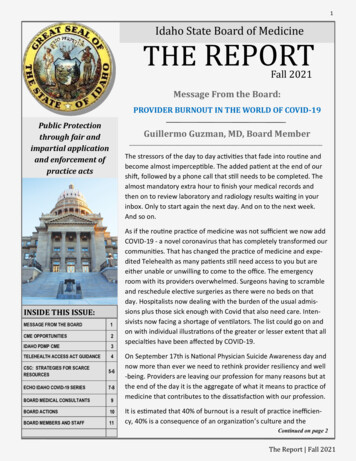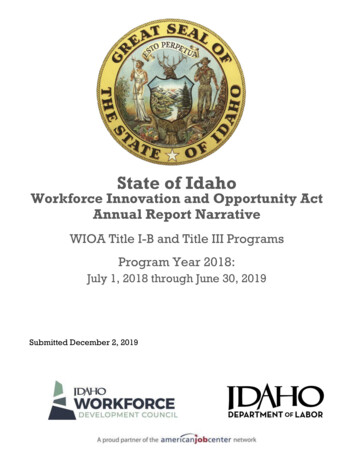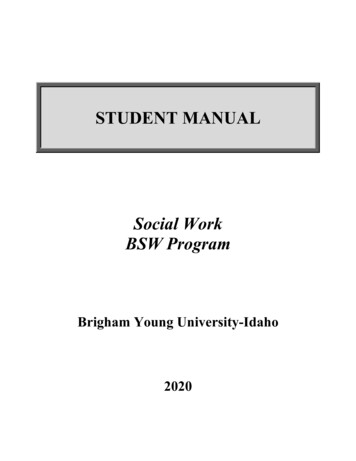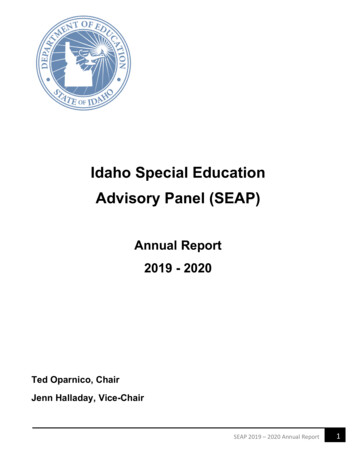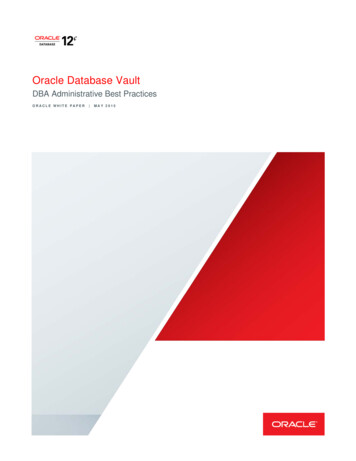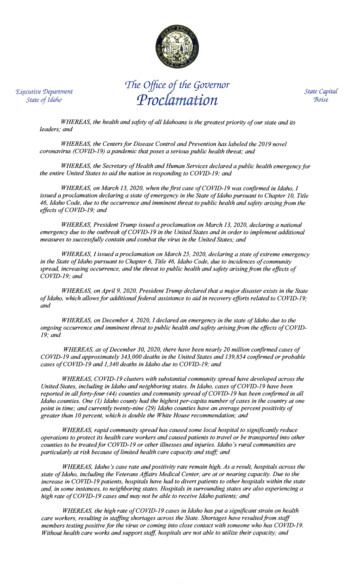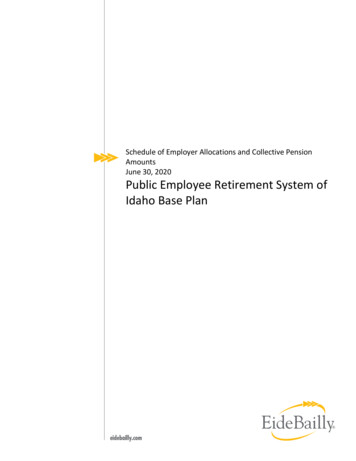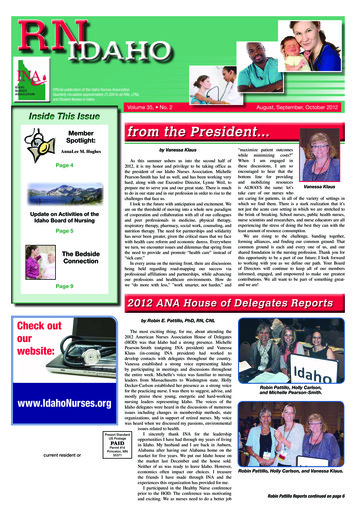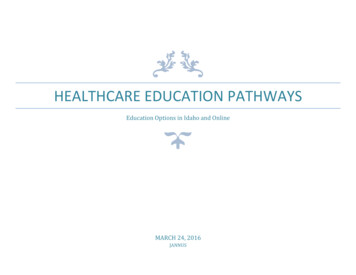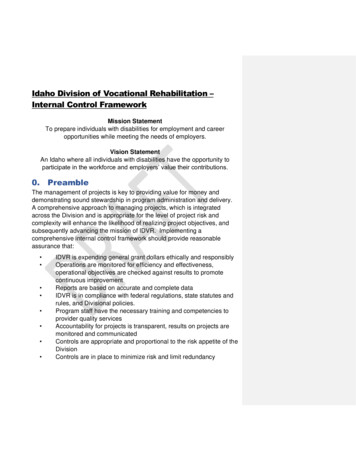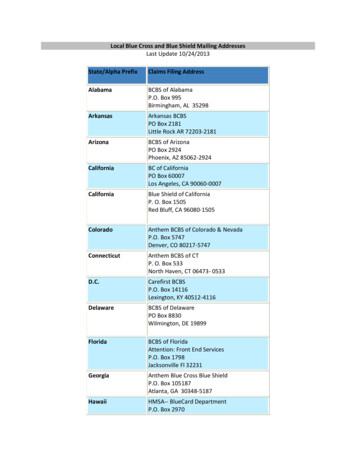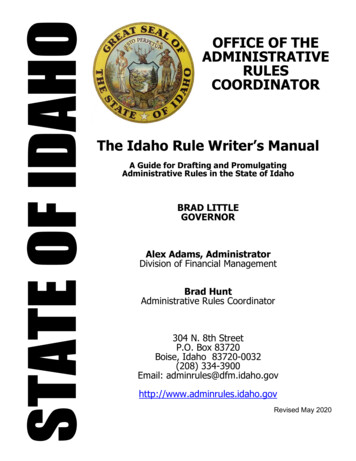
Transcription
OFFICE OF THEADMINISTRATIVERULESCOORDINATORThe Idaho Rule Writer’s ManualA Guide for Drafting and PromulgatingAdministrative Rules in the State of IdahoBRAD LITTLEGOVERNORAlex Adams, AdministratorDivision of Financial ManagementBrad HuntAdministrative Rules Coordinator304 N. 8th StreetP.O. Box 83720Boise, Idaho 83720-0032(208) 334-3900Email: o.govRevised May 2020
Table of ContentsThe Idaho Rule Writer’s ManualADMINISTRATIVE LAW OVERVIEW . 4THE ADMINISTRATIVE PROCEDURE ACT . 6HIERARCHY OF STATE DOCUMENTS . 7ADMINISTRATIVE RULES OF THE STATE OF IDAHO . 8Negotiated Rulemaking . 8Proposed Rulemaking . 11Temporary Rule . 14Pending Rule . 16Final Rule . 18LEGISLATIVE REVIEW OF RULES . 19INCORPORATION BY REFERENCE . 23PUBLIC PARTICIPATION IN RULEMAKING . 26THE RULEMAKING RECORD . 29RULE NUMBERING AND DOCKETING SYSTEM . 30How to Use the Idaho Administrative Code and Bulletin . 30Docketing System Used In Rulemaking . 31RULE ORGANIZATION AND FORMATTING . 32Organization Within the Chapter - Required Sections . 32Section and Subsection Formatting . 32Reserved Sections . 34Break in Continuity of Sections . 34Legislative Format . 35Effective Dates . 35USE OF PLAIN LANGUAGE . 38Page 2
RULE WRITER’S MANUALTable of ContentsRULE WRITING STYLE, FORMAT, AND CONTENT . 40Introduction . 40General Rule Writing Guidelines . 40Style . 41Consistency . 41Simplicity . 41Clarity . 42Repeal, Rewrites, and New Chapters . 43Renumbering . 44Content - General Guidelines and Content Related Issues . 44Number and Gender . 44Punctuation . 45Capitalization . 45Numbers in Text . 46References to Idaho Code, Idaho Administrative Code, and Other Laws . 48Ordinal Numbers - First, Second, Etc. . 48Formulas . 48Words and Phrases . 49Citations to Other Rules or Codes . 52LEGAL NOTICE - NEWSPAPER PUBLICATION . 54RULE PROMULGATION: STEP-BY-STEP PROCEDURES . 55CONTACT LIST . 57USEFUL WEBSITES . 58Page 3
ADMINISTRATIVE LAW OVERVIEWFrom a practical standpoint administrative rules have a far greater effect on people’s daily lives thando the laws of the state. It is through the administrative rules that a governmental agency implements,prescribes, or interprets the statutes passed by the legislature. The promulgation and implementationof administrative rules to carry out or enforce the statutory or policy mandates imposed through law orestablishing its process or procedure requirements are the primary functions of most state agencies. Itis through the enforcement and application of the rules that a person’s ability to engage in a specificactivity or occupation or to qualify for public assistance, for example, is allowed or prevented.Protecting the public health, safety and welfare is also a primary function of government and many ofthese legal protections are prescribed through administrative rules. So, in most cases, whether it is alaw or rule that is being imposed, it matters very little because the effect is the same.Because administrative rules are very pervasive in our lives, agency rulemaking is a very seriousundertaking. For this reason, Idaho’s rulemaking process requires that proper and timely notice begiven to the public and that ample opportunity be provided to the public to participate in rulemaking.This has helped make the process of implementing Idaho’s statutory laws more transparent and hasclarified how the practice and procedure requirements of our governmental agencies are establishedand put into practice.The Idaho Administrative Procedure Act (Title 67, Chapter 52, Idaho Code), which governsrulemaking in Idaho, defines rulemaking as the process for the formulation, adoption, amendment, orrepeal of a rule. This process can be driven by a number of different events but two of the mostcommon are the enactment of a new or amended statute by our state Legislature or the enactment of anew law or regulation by the federal government. However, a citizen’s petition to amend or adopt anew rule, a change in an agency’s process or procedure requirements, a court order, or the need tosimply update the rule or do some housekeeping can cause an agency to initiate rulemaking and set theprocess in motion.A statutory or regulatory change may require an agency to adopt new administrative rules or reviseexisting rules to carry out statutory or regulatory provisions or other legal mandates. Through rules theagency interprets, prescribes, and implements statutory law or policy, and clarifies, standardizes, orestablishes its procedure or practice requirements. This rulemaking authority is derived from statutorylaw and is, essentially, an agency’s ability to make “law” under powers granted by the Legislaturethrough statute. All rules promulgated within the authority conferred by statute, and in accordancewith the Administrative Procedure Act (APA), have the full force and effect of law and must beregarded as such. However, an administrative rule does not rise to the level of statutory law and statutealways takes precedent over rule if there is ever a conflict between the two.Idaho’s statutory definition of a “rule” has a slightly different meaning than that of the federalgovernment and several other states. In Section 67-5201(19) of the Idaho Administrative ProcedureAct, the concept is broadly defined:(19) “Rule” means the whole or part of an agency statement of general applicabilitythat has been promulgated in compliance with the provisions of this chapterand that implements, interprets, or prescribes:(a)law or policy, or(b)the procedure or practice requirements of an agency. The term includesthe amendment, repeal or suspension of an existing rule, but does notPage 4
include:(i)statements concerning only the internal management or internalpersonnel policies of an agency and not affecting private rights ofthe public or procedures available to the public; or(ii)declaratory rulings issued pursuant to Section 67-5232, IdahoCode; or(iii) intra-agency memoranda; or(iv) any written statements given by an agency which pertain to aninterpretation of a rule or to the documentation of compliance with arule.It is necessary to have a clear understanding of this statutory definition when determining what canand cannot be promulgated as a rule. The statutory definition is broad enough that making thisdetermination can be difficult. In order to meet and not exceed the legislative intent of the authorizingstatute, and to withstand legislative scrutiny or judicial review, the rule must fall within this definition.A rule that is not promulgated in compliance with the procedural requirements of the APA is voidable.Likewise any rule that is found to have exceeded or fails to meet the intent of the authorizing statue, orone that goes outside its substantive rulemaking authority, may be voided. Differing interpretations ofa statute or the ambiguity of a law’s legislative intent add to the difficulty of writing a rule that willsurvive the journey from inception to final adoption.The courts have also weighed in on rulemaking and in some cases have required agencies topromulgate rules to enforce what previously may have been an agency policy or guideline. Whilethese court decisions are generally limited in scope and affect only specific laws and rules, the courtshave expanded the definition of rule in these cases to include more ambiguous regulatory practicesthat cannot be applied “generally” and appear to be at odds with the statutory definition. The conceptof “general applicability” doesn’t always work well with certain environmental or wildlifemanagement laws, for instance, because a rule that may be needed in one area or body of water in thestate cannot be applied generally or uniformly throughout the state. The courts have been careful notto redefine the statutory definition and in these cases have provided a guideline for determining thatwhen something walks and talks like a rule, it should be a rule even though it may fall short of thestricter statutory definition.The rule promulgation* process in Idaho is made up of very specific legal requirements that an agencymust follow, and the actions taken by the agency when conducting rulemaking must follow a specificorder. Not all rulemakings are the same and they can vary slightly in each case; however, the order inwhich those actions are taken cannot. It is incumbent on the rule writer to be aware of what is requiredwhen entering into rulemaking and know which legal requirements apply to each specific rulemaking.In order for a rule to become final and effective and have the full force and effect of law, the processmust closely adhere to the requirements outlined in the Idaho Administrative Procedure Act.*Promulgation means to publicize or make public. As used in the context of Idaho rulemaking, promulgation meansto make known to the public through the publication of the Administrative Bulletin and the Administrative Code allrulemaking documents that are required by law to be published and made public.Page 5
THE ADMINISTRATIVE PROCEDURE ACTTitle 67, Chapter 52, Idaho CodeSections 67-5201 through 67-5292The Administrative Procedure Act (APA) is organized into five subject matter areas: definitions,rulemaking, contested case proceedings, judicial review, and legislative rules review.a. Definitions - Introductory Provisions:I.C. Sections 67-5201 through 67-5207These sections of Idaho Code create the Office of the Administrative Rules Coordinator anddelimit the authority of the Rules Coordinator. They also establish the two official administrative rulespublications: the Idaho Administrative Bulletin and the Idaho Administrative Code. These provisionsset fees for the promulgation, publication, and dissemination of state agency administrative rules andestablish the Administrative Code fund into which all fees are paid. These sections also require rulepromulgation by the Attorney General (IDAPA 04.11.01) to implement the provisions of Sections 675220 through 67-5232 and 67-5240 through 67-5255.b. Rulemaking:I.C. Sections 67-5220 through 67-5232These sections provide the framework for agency rule promulgation and related responsibilities,public participation in rulemaking, incorporation by reference, interim legislative review of proposedrules, petition for adoption of rules, and declaratory rulings by agencies.c. Proceedings for Contested Cases:I.C. Sections 67-5240 through 67-5255Establishes procedures for contest case proceedings and agency administrative hearings. Fourdistinct orders may result from a contested case hearing: recommended, preliminary, final, andemergency.d. Judicial Review:I.C. Sections 67-5270 through 67-5279Rules, contested cases, and the agency’s performance of, or failure to perform, any duty placed onit by law are subject to judicial review. The standard that the court applies depends on the nature of theproceeding.e. Legislative Review of Rules:I. C. Section 67-5291Provides for formal legislative review for final approval of agency rules by the standing germanecommittees of the legislature and outlines actions that can be taken on certain rules and actions thatmust be taken on certain rules.f. Expiration of Administrative Rules:I.C. Section 67-5292Provides that all rules automatically expire on July 1 of each year unless extended by statute eachyear.Page 6
HIERARCHY OF STATE DOCUMENTSIDAHO CONSTITUTIONLEGISLATIVE STATUTES (IDAHO CODE)STATE AGENCY RULES (ADMINISTRATIVE CODE)POLICIESPROCEDURESGUIDELINES AND OTHER WRITTEN INTERPRETATIONSAs with most organizations, a hierarchy is established to define the levels of precedent for state government documents. To illustrate these various levels, the analogy of a pyramid is useful. Each increasinglevel becomes smaller in size, yet greater in scope. The state Constitution creates the branches of government and establishes the legislature law-making authority. The laws create the agency and defines andrestricts the agency’s authority, which in turn restricts the scope of its rulemaking powers.Idaho Constitution: Supreme law of the land; very difficult to change; framework of the government.Legislative Statutes (Idaho Code): Legislative branch of government creates the uniform laws fromwhich society must operate. Law usually contains: 1) a program the Legislature wants accomplished; 2)the executive branch agency it designates to carry out the program; and 3) guidelines for implementation.Agency Rules (Administrative Code): The executive branch of government is broken into varioussubdivisions known as departments, agencies, divisions, offices, bureaus, boards and commissions.Rulemaking is the law-making power of these subdivisions and is governed by the AdministrativeProcedures Act. Rules carry the force and effect of law and interpret, prescribe or implement a law orpolicy or the procedure and practice requirements of an agency. Agencies are charged with implementingand enforcing laws the Legislature passes. Rules made under the statutory authority are general in scopeand they are made to apply to all persons in a class, not to particular parties or single individuals, and mustbe applied equally. Because the statute normally does not contain all details, the designated agency mustinterpret the Legislature’s intent and develop a method to implement the program. Agencies do notoriginate state policy, but rather, they implement state policy through their administrative rules.Policy: Mission statement. A general statement with no specifics. It is a high-level, overall plan embracingthe general goals, acceptable methods, actions, and conduct of an agency. Usually an internal managementtool used in the day-to-day operation of the agency. Does not have the force and effect of lawProcedure: Step-by-step implementation of policy. Does not have the force and effect of law.Guidelines: Description of procedures. Does not have the force and effect of law.Page 7
NEGOTIATED RULEMAKINGWhat Is Negotiated Rulemaking?In those instances when an agency has some control over the formulation of the substantive content ofa rule and it has determined that it is a feasible undertaking, negotiated rulemaking must be conductedby the agency with interested persons. This requirement of the APA is intended to improve thesubstance of the rule through a consensus building process. The agency must engage or attempt toengage any person who may be affected by the rulemaking and those may want to provide input andparticipate in the formulation of the proposed rule.Negotiated rulemaking provides an opportunity for all interested and affected persons and the agencyto discuss possible changes to the rule and attempt to reach a consensus on the proposed amendmentsthat would, ultimately, result in a proposed rule that would then be promulgated by the agencyfollowing regular (formal) rulemaking procedures.Negotiated rulemaking is an informal part of the rulemaking process that precedes all formalrulemaking proceedings. (The publication of a proposed rule is considered the “formal” initiation of arulemaking.) Negotiated rulemaking is considered an informal part of the process because the agencyhas some leeway in how it conducts the negotiated meetings. This flexibility is intended to facilitateparticipation by the greatest number of persons who might be affected by the possible rule changes.Constituencies vary greatly between agencies and a process that works well for one agency may notwork at all for another.Another reason for this less structured format is that the result of the “negotiations” may be that theagency does not initiate formal rulemaking procedures and the rulemaking effectively stops before itever starts. There are no time constraints on the agency to finish negotiations, nor is there a limit onthe number of meetings that can be held by the agency when conducting negotiated rulemaking. Theagency proceeds as necessary and until such time that it feels it has met its statutory requirements toprovide adequate and ample opportunity for participation by affected persons or when it hasformulated a proposed rule that is acceptable to most participants.Is It Feasible?As stated in Section 67-5220, Idaho Code, prior to initiating formal rulemaking procedures, an agencymust determine if conducting negotiated rulemaking is a feasible undertaking. If the agencydetermines it is not feasible, it may proceed to formal rulemaking and explain in the notice ofproposed rulemaking why it was not feasible to conduct negotitated rulemaking. When determiningthe feasibility of negotiated rulemaking, certain issues must be considered. These may include thefollowing:Is there a need for temporary rulemaking?What is the nature of the change(s) being proposed? Is it a simple change?Are those who will be affected by the rule changes easily identifiable?Are those affected likely to reach a consensus on the proposed changes?Is the rulemaking being done to comply with a state or federal statute or court order?Answers to these and similar questions should help the agency decide if conducting negotiatedPage 8
rulemaking is necessary or if it should proceed directly to proposed rulemaking.Additionally, a rulemaking that is being done to comply with an existing state or federal law orregulation or a controlling judicial decision or court order cannot be negotiated. The agency’s abilityto negotiate the content of the rule is negated by these overriding mandates.The agency’s determination of whether negotiated rulemaking is feasible is not subject to judicialreview. However, it is subject to legislative scrutiny during the legislative rules review process. TheLegislature views the use of negotiated rulemaking as an important step in the formulation ofproposed rules and the agency should be prepared to explain in detail to the reviewing legislativecommittee why negotiated rulemaking was not conducted.The “Notice of Intent to Promulgate a Rule” (Negotiated Rulemaking)An agency must publish a “Notice of Intent to Promulgate a Rule” in the Bulletin whenever itdetermines that the changes to the rule being sought meet the feasibility standard for negotiatedrulemaking. This notice is an invitation from the agency to the public and interested persons to discussthe proposed changes to the rule. At a minimum the notice must provide the following:a) a brief description of the subject matter and purpose of the rule;b) the statutory authority for the rulemaking, both state and federal;c) the principal issues involved;d) a reasonable amount of time to respond to the agency’s invitation to participate;e) an agency contact to whom comments and questions may be sent; andf) the agency web address where all related rulemaking postings can be accessed.The agency has two options when publishing a Notice of Intent to Promulgate in the Bulletin. Oneoption is more preemptive than the other in that the agency schedules negotiated meetings and lists thedates, times and locations for those meetings. This is similar to the scheduling of public hearings thatis seen in the Notice of Proposed Rulemaking. Interested persons simply follow the guidance providedin the notice if they wish to participate.In the second option, there are no scheduled meetings. The notice instructs those who may beinterested to contact the agency if they want to take part in the negotiated process. In other words, thenotice is an open invitation to the public requesting interested persons to contact the agency asinstructed in the notice. Any preliminary drafts or other materials related to the rulemaking must bemade available to the public by posting this information on the agency website.The agency may also schedule meetings and invite persons to attend these scheduled meetings ratherthan inviting anyone who may be interested to respond. However, if meetings are not scheduled andnoticed, the agency must provide notice of meetings to interested persons who respond to the “Noticeof Intent to Promulgate a Rule.” A notice of the meeting(s) schedule MUST be posted on the agencywebsite and may also be published in the Bulletin.In those instances where little or no response to the Notice of Intent to Promulgate is received withinthe time provided, the agency may proceed directly to formal rulemaking. At this point negotiatedrulemaking is no longer feasible because of a lack of interest by stakeholders or others. A briefsummary document must be posted on the agency website detailing that no meetings were held due toa lack of response to the notice and that the agency has initiated formal rulemaking procedures.Page 9
Posting of preliminary draft by the agency is optional. In order to give stakeholders and otherinterested persons a starting point for discussing possible rule changes, the agency may prepare a draftof potential amendments to the rule. This draft must be made available to anyone interested and itmust be posted to the agency website for viewing or downloading. The rule writer should avoidcalling these draft documents “proposed rules” because it can lead to confusion since the reason forconducting negotiated meetings is to develop a proposed rule that would then be published in theBulletin as part of the formal rulemaking.Meeting FormatThe agency is free to invite separate groups at separate times, hold several meetings to include allinterested parties, invite written comments, etc. This part of the rulemaking process is intentionallyflexible and informal. Meetings should be designed to “negotiate” the proposed changes or ideas withthose who will be affected. There is no legal time limit on this process. The intention is that thesemeetings result in the formulation of a proposed rule and regular rulemaking proceedings are initiated.However, in some cases, the result of the “negotiations” may be that formal, regular rulemaking is notinitiated, rulemaking activities cease, and no additional action is taken.As in all rulemaking activities, an official rulemaking record must be prepared by the agency wheninitiating negotiated rulemaking. The rulemaking record must include all information required by theAPA in Sections 67-5220 and 67-5225, Idaho Code.What Are the Advantages to Negotiated Rulemaking?*Negotiating the substantive content of the rule text before it is published in theAdministrative Bulletin can save time and money because, in many instances, thediscrepancies in the amendments or potential problems can be resolved beforecommitting additional resources to the rulemaking.*It can improve the substance of proposed rules by drawing upon shared information,expertise, and technical abilities possessed by the affected persons.*It aids in arriving at a consensus on the content of the rule.*Expedites formal rulemaking.*Lessens the likelihood that affected persons will resist enforcement or challenge therules in court.*Public and industry constituents are generally more satisfied with the outcome ifincluded in the process in the beginning rather than at the end, or not at all.*Negotiated rulemaking is an informal process. Public hearings on rulemakings areheld only to receive testimony and comments. Negotiated rulemaking meetings allowfor interactive discussions on the subject matter between the parties in an attempt toreach consensus on the content of the proposed rule.Page 10
PROPOSED RULEMAKINGWhat is a Proposed Rule?A formal, written proposal by the agency to adopt a new rule or amend or repeal an existing rule inaccordance with the APA is called a proposed rule. With very few exceptions, all codified rules thatcomprise the Administrative Code were promulgated as proposed rules and were published in theAdministrative Bulletin before they became final and enforceable. Proposed rulemaking is a legalprocess with strict procedural requirements that must be followed before a rule has the force and effectof law. The following excerpt from the APA outlines what must take place once an agency initiatesregular rulemaking proceedings and files a notice of proposed rulemaking for publication in theAdministrative Bulletin.As stated in Section 67-5221(1), Idaho Code, prior to the adoption, amendment, or repeal of a rule theagency must publish a ‘Notice of Rulemaking - Proposed Rule’ in the Bulletin. The notice mustinclude the following information:(a) The specific statutory authority for the rulemaking including a citation to the specificsection of the Idaho Code that has occasioned the rulemaking, or the federal statute orregulation if that is the basis of authority or requirement for the rulemaking;(b) A statement in nontechnical language of the substance of the proposed rule, including aspecific description of any fee or charge imposed or increased;(c) A specific description, if applicable, of any negative fiscal impact on the state generalfund greater than ten thousand dollars ( 10,000) during the fiscal year when thepending rule will become effective; provided, however, that notwithstanding section67-5231, Idaho Code, the absence or accuracy of a fiscal impact statement providedpursuant to this subsection shall not affect the validity or the enforceability of the rule;(d) The text of the proposed rule prepared in legislative format;(e) The location, date, and time of any public hearings the agency intends to hold on theproposed rule;(f) The manner in which persons may make written comments on the proposed rule,including the name and address of a person in the agency to whom comments on theproposal may be sent;(g) The manner in which persons may request an opportunity for an oral presentation asprovided in Section 67-5222, Idaho Code; and(h) The deadline for public (written) comments on the proposed rule.(i) If negotiated rulemaking was not conducted, an explanation of the agency'sdetermination that negotiated rulemaking was not feasible.Each agency that has a website must make the ‘Notice of Rulemaking - Proposed Rule’ accessiblefrom its website either by posting a copy of the notice on the agency website or by providing a link tothe Bulletin where the notice was published so that interested persons can view it online. Linking tothe Bulletin is the preferred method for accessing the notice.Page 11
The Adm
The Idaho Rule Writer’s Manual A Guide for Drafting and Promulgating Administrative Rules in the State of Idaho BRAD LITTLE GOVERNOR Alex Adams, Administrator Division of Financial Management Brad Hunt Administrative Rules Coordinator 304 N. 8th Street P.O. Box 83720 Boise, Idaho
